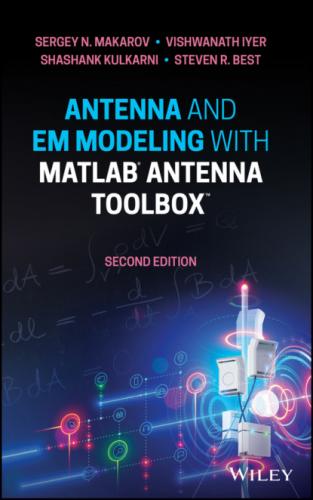Emphasize that the quarter wave transformer is relatively narrowband; it cannot be used for antenna matching over a wide band. Also, some reflections and standing waves will occur along the quarter wave line.
1.11 REFLECTION COEFFICIENT EXPRESSED IN DECIBELS AND ANTENNA BANDWIDTH
It follows from the previous discussion that the major dimensionless parameter that characterizes antenna matching is the antenna reflection coefficient, Γ. To highlight the physical meaning of the reflection coefficient and its acceptable threshold, we rewrite Eq. (1.17) for the antenna power one more time:
and let |Γ|2 to have the value of 0.1. According to Eq. (1.30), this means that the power delivered to the antenna is exactly 90% of the maximum available antenna power. Simultaneously, the reflection coefficient in dB (or power reflection coefficient),
(1.31)
will attain the value of −10 dB. Since ideal antenna matching (|Γ|=0 or |Γ|dB = − ∞) is never possible over the entire frequency band, it is a common agreement that, if
uniformly over the band, then the antenna is said to be matched over the band. In other words, at least 90% of available power from the generator will be delivered to the antenna for any frequency within the band. When applied over a frequency band, Eq. (1.32) thus determines the antenna impedance bandwidth or simply the antenna bandwidth. Several such bands may be present for a multiband antenna.
The TX antenna may be treated as a one port (port 1) of an electric linear network, whereas the other ports (if present) are other antennas. An example is given by a transmit/receive antenna pair, which form a two‐port linear network. In that and similar cases,
(1.33)
where S11 is the port 1 complex reflection coefficient or the first diagonal term of a multi‐port scattering matrix
Note:
Along with the reflection coefficient in dB, |S11|dB is always nonpositive. The terminal condition |S11|dB = 0 dB corresponds to a complete reflection of the voltage generator signal from the antenna. Nothing is being radiated.
Note:
Meanings of the complex reflection coefficient Γ itself and the dB measure of its magnitude, 20log10|Γ|, are often interchanged. For example, if an antenna datasheet reports “antenna reflection coefficient as a function of frequency,” it is 20log10|Γ| that is being plotted (cf. Figure 1.8 as an example).
Using MATLAB Antenna Toolbox, determine antenna impedance bandwidth for the blade dipole antenna with lA = 15 cm, w = 8 mm.
Solution: The approximate resonant frequency of the half wave dipole with the length of 15 cm is about 1 GHz. We again choose the frequency band from 200 to 1200 MHz for testing. A simple MATLAB script given below initializes the dipole antenna, plots the antenna geometry, and computes the dipole reflection coefficient Γ = S11. Note that the computations are performed exactly following Eq. (1.17), i.e. without an extra cable. Figure 1.8 shows the resulting dipole geometry and the reflection coefficient comparison with the analytical result obtained from Eq. (1.14). The agreement between two solutions is good while the numerical solution is again expected to be somewhat more accurate for this particular geometry. Note that the exact reflection coefficient values below −10 dB do not really matter, they are very sensitive to small variations of the antenna impedance around 50 Ω and are subject to noise.
%% Setup analysis parameters f = linspace(200e6, 1200e6, 1000); % Frequency, Hz lA = 0.15; % Dipole total length, m a = 0.002; % Dipole radius, m %% Antenna toolbox model and analysis w = cylinder2strip(a); % Eq. strip width model d = dipole('Length',lA,'Width',w); % Strip dipole model figure; show(d) % Visualize geometry S11 = rfparam(sparameters(d,f,Rg),1,1); % Calculate s-parameters S11dB = 20*log10(abs(S11));
Figure 1.8 Magnitude of the reflection coefficient in dB for the dipole antenna and the antenna impedance bandwidth. Numerical solution is shown by a dashed curve.
In Figure 1.8, the antenna impedance bandwidth follows Eq. (1.32) or (1.34) with the minus 10 dB threshold. The threshold is shown by two dashed lines in Figure 1.8. The dipole antenna has the impedance bandwidth from the lower frequency of the band, fL = 870.7 MHz, to the upper frequency of the band, fU = 985.8 MHz (analytical solution is considered as an example). The center frequency of the band is given by
(1.35)
The antenna impedance bandwidth BW (or fractional bandwidth) is determined in the form
which is a very typical value for a wire dipole or a thin‐blade
